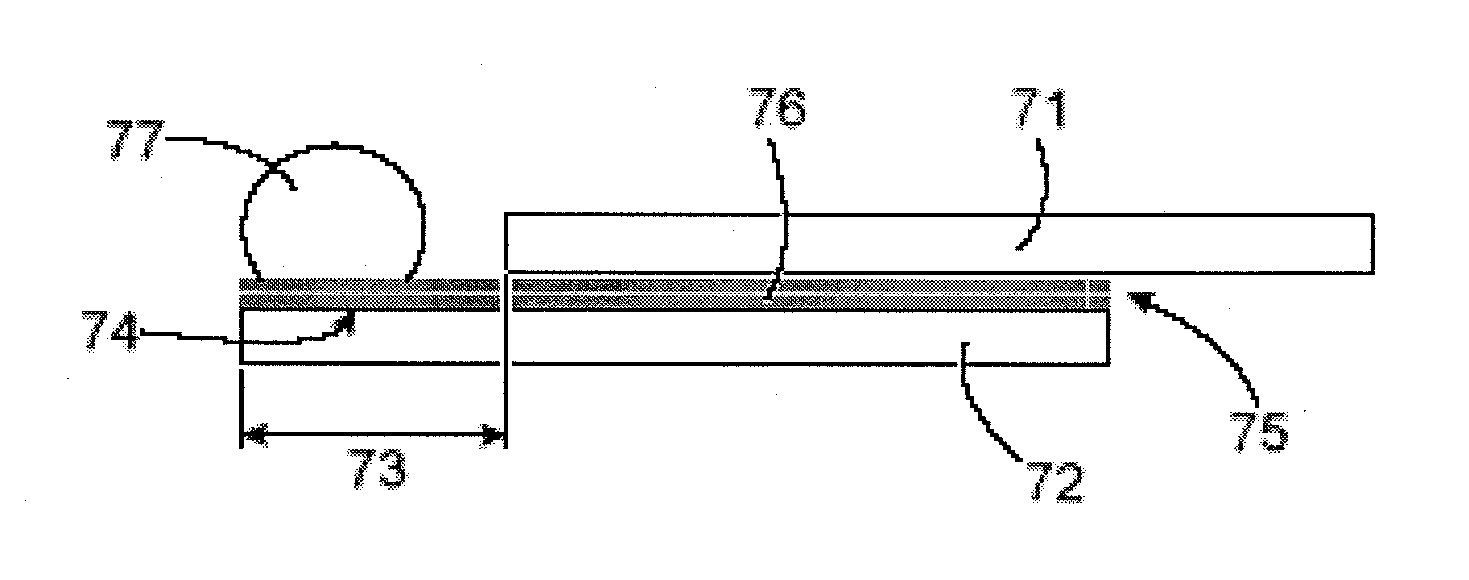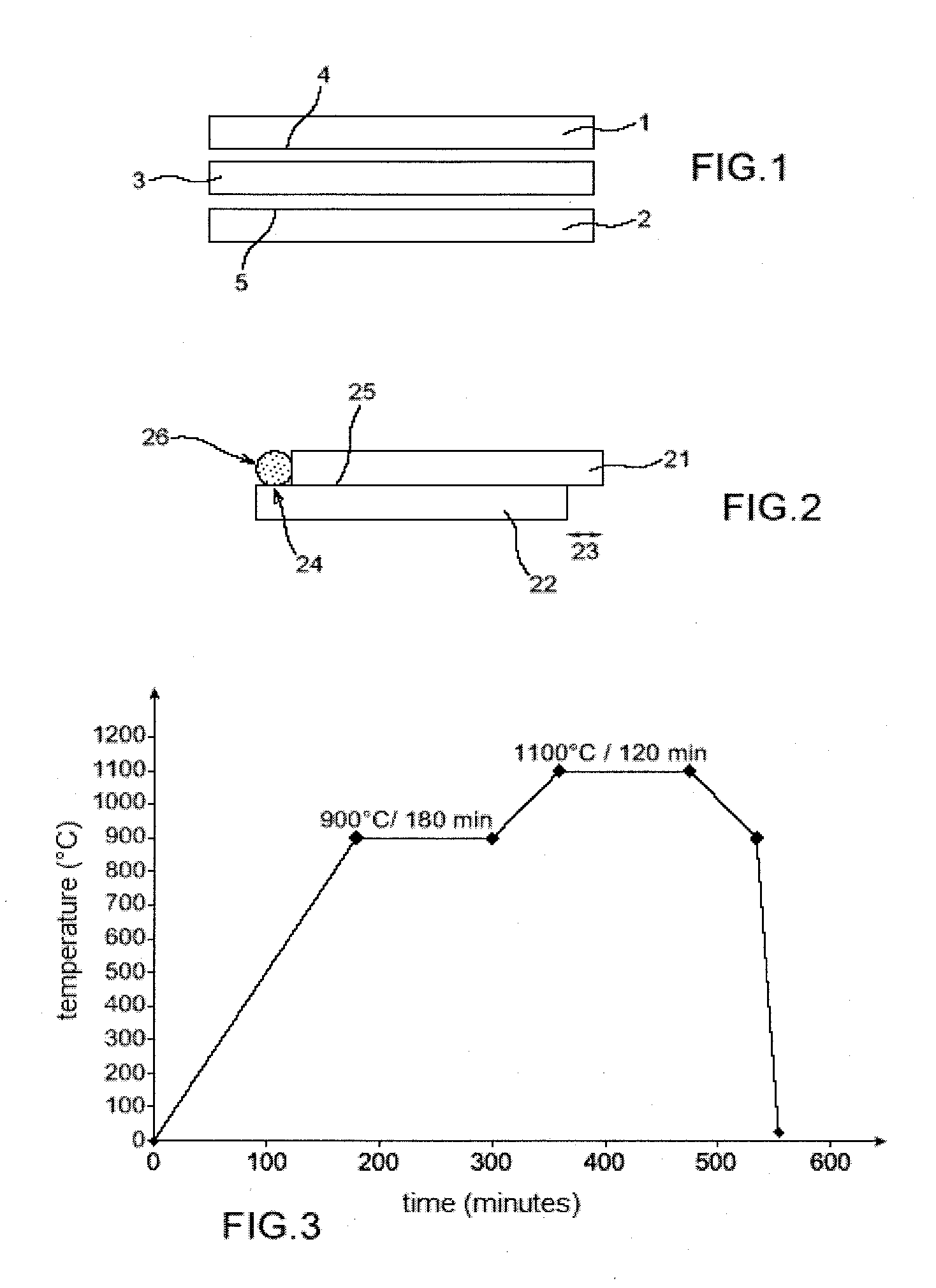METHOD OF JOINING PARTS MADE OF SiC-BASED MATERIALS BY NON-REACTIVE BRAZING WITH ADDITION OF A REINFORCEMENT. BRAZING COMPOSITIONS AND JOINT AND ASSEMBLY THAT ARE OBTAINED BY SUCH A METHOD
- Summary
- Abstract
- Description
- Claims
- Application Information
AI Technical Summary
Benefits of technology
Problems solved by technology
Method used
Image
Examples
example 1
[0274]This example describes sessile drop tests performed with a brazing composition, braze alloy of the invention of composition 64% Si and 36% Ni (atomic percentage) i.e. 46% Si and 54% Ni in mass percentage, on sintered pure α-SiC observing a single brazing plateau at 1100° C.
[0275]a) Preparation of the Brazing Composition and Brazing Paste
[0276]The brazing composition concerned: 64 atomic % Si and 36 atomic % Ni was prepared from pieces of pure Si and pieces of pure Ni.
[0277]These pieces were weighed paying heed to the proportions of the brazing composition and placed in an alumina crucible. The assembly was placed in a metal furnace and subjected to a heat cycle with a plateau at 1250° C. under argon for 120 minutes.
[0278]After cooling, this gave an ingot. This ingot was crushed to obtain a powder.
[0279]An organic binder (NICROBRAZ® cement) was added to this mixture of powders to form a viscous paste.
[0280]b) Sessile Drop Test at 1100° C.
[0281]The brazing paste thus prepared wa...
example 2
[0289]This example describes sessile drop tests performed with a brazing composition, braze alloy of the invention having the composition 64% Si and 36% Ni in atomic percentages i.e. 46% Si and 54% Ni by mass, on a SiC / SiC Cerasep A40C® composite, observing a single brazing plateau at 1100° C.
[0290]a) Preparation of the Brazing Composition and Brazing Paste
[0291]The brazing composition concerned: 64 atomic % Si and 36 atomic % Ni was prepared as in Example 1.
[0292]A paste of brazing composition was formed as in Example 1.
[0293]b) Sessile Drop Test at 1100° C.
[0294]The brazing paste thus prepared was used to form a small mound of braze alloy of mass in the order of 50 mg. This mound of braze alloy was deposited on a plate of SiC / SiC composite with SiC matrix and SiC fibres. This composite is available from Snecma Propulsion Solide under the trade name CERASEP A40C®. This plate was previously cleaned before depositing the braze alloy.
[0295]The assembly of the mound of braze alloy and ...
example 3
[0302]This example describes the preparation of bonds, joining between two parts made of sintered pure α-SiC silicon carbide using the brazing method according to the invention, the brazing being conducted in capillary configuration using a brazing composition, braze alloy of the invention composed of 64 atomic % Si and 36 atomic % Ni i.e. 46 mass % Si and 54 mass % Ni. This example also describes tests, mechanical testing performed on these assemblies.
[0303]a) Preparation of the Brazing Composition, of the Brazing Paste and of the Parts to be Assembled, Joined
[0304]The brazing composition concerned, namely 64 atomic % Si and 36 atomic % Ni was prepared in the manner described in Example 1.
[0305]A paste of brazing composition was prepared as in Example 1.
[0306]The parts made of sintered SiC to be assembled were plates of size 20×10 mm2 and thickness of 1.5 mm.
[0307]The parts were cleaned with acetone then ethanol and finally dried.
[0308]The substrates, parts were placed in contact l...
PUM
| Property | Measurement | Unit |
|---|---|---|
| Temperature | aaaaa | aaaaa |
| Temperature | aaaaa | aaaaa |
| Temperature | aaaaa | aaaaa |
Abstract
Description
Claims
Application Information
 Login to View More
Login to View More - R&D
- Intellectual Property
- Life Sciences
- Materials
- Tech Scout
- Unparalleled Data Quality
- Higher Quality Content
- 60% Fewer Hallucinations
Browse by: Latest US Patents, China's latest patents, Technical Efficacy Thesaurus, Application Domain, Technology Topic, Popular Technical Reports.
© 2025 PatSnap. All rights reserved.Legal|Privacy policy|Modern Slavery Act Transparency Statement|Sitemap|About US| Contact US: help@patsnap.com



